Learning to Know Sheep and to Handle them Gently — Mutually Complementing Goals
When you start off with raising sheep, you might not find it exactly evident that sheep can be handled in a stress-free manner, without them trying to escape at every possible moment. We got our initial sheep-related experiences with ones from a large flock who didn’t let us approach themselves closer than about 10 meters. At the same time, experience shows that even if your sheep are friendly and let themselves be hand-fed and stroked, they somehow sense the onset of uncomfortable procedures and in such cases, they often don’t want to be caught.
At the time of this writing, our third summer with sheep has just ended. We have raised most of the animals in the flock from the ground up. Now we are in a situation where we can confine our sheep for the necessary procedures by just calling them. It must be noted that we are hobby shepherds with only 5 sheep staying for the winter. In large flocks, the priorities and approaches may be totally different.
This post will be written in a chronological order, following our course of learning. Throughout this time, we have been guided by a will to learn to know sheep, patience to observe them for long periods of time, and a strive for effective solutions.
Getting Used to People
The first step towards handling sheep in a stress-free manner is to get them accustomed to being around the people who will handle them. Generally, based on what we have heard from shephers and read in literature, a common recommendation seems to be to “go into the flock”, i.e. to spend lots of time and often, with sheep. If necessary, you may confine yourself with the sheep in a small space. Bread as well as pelleted feed are useful in both formulating as well restoring friendships.
Getting the sheep used to people is not a one-off endeavor. One must continuously seek contact with them and keep restoring the friendships, regardless of the season. Otherwise you become a stranger for them quite soon, we have found. In this picture we can see an example of a year-round relationship of mutual trust between the sheep and the shepherd.
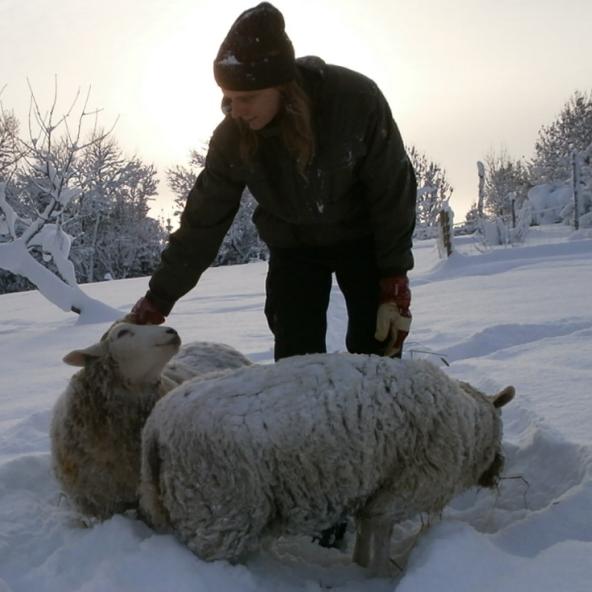
Sven is stroking K
Following a Human Being
By their nature, sheep are flock animals, and they follow a leader. It turns out that if the shepherd succeeds at making friends with sheep, one can as well become the “leading ewe or ram”. Often when I step outside in the morning, I am greeted by loud baaing and the sheep run up to me, and show interest in following me. Mostly this happens during the fall-winter season when I bring them something tasty every morning (some pelleted feed or some apples). In the summer they are more lazy because why bother running if there is no hope for reward.
The video below is of low quality but nevertheless, it depicts one possible way of communication between the sheep and the shepherd both in sound and in picture.
During this summer, having the sheep accustomed to us and ready to follow us, the next logical step for me was to try and learn to take care of them and shear them in a way that would not involve any kind of chasing, any need to apply physical force or any mental stress. At most times, me and Sven handle our sheep together but I would like to be able to shear them, for instance, totally on my own if necessary.
Selecting a Space with the Correct Dimensions
Here is a picture of a seemingly idyllic outdoor barbecue space that our sheep have occupied and where we have carried out most of the procedures with them from the beginning (injections, shearing, applying ear tags).
A quiz for the reader: how many sheep would be comfortably handled in a space of such size? What problems will the “furniture” cause?
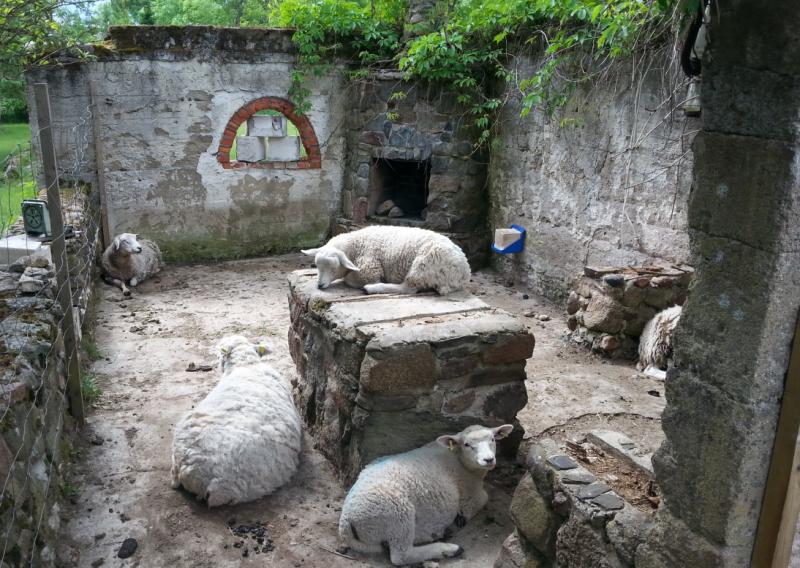
I can see two main problems with this setup: this building is too large for handling 5 to 10 sheep, to begin with. Now add the furniture that the sheep can jump up and down while running and you get a situtation where catching a single sheep for treatment requires quite a bit of strength, courage and experience. In such a situation both the animals and the beginner shepherd gain an experience of fear – or at least they get really tired.
An ideal concentration of sheep for stress-free handling can be see in the picture below, above the red lines.
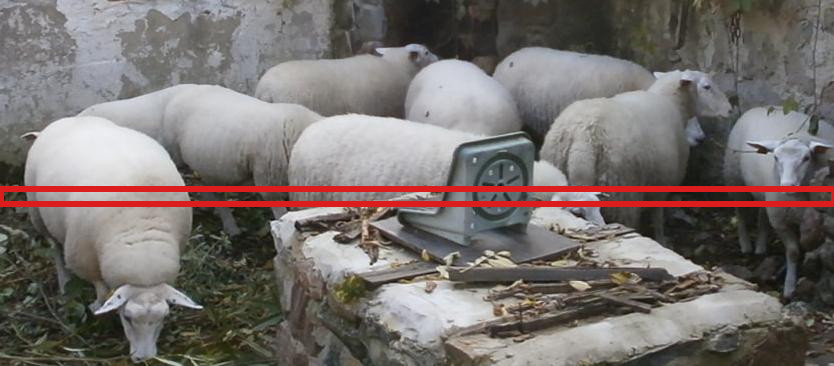
If confined quite tightly as depicted, the sheep have no space for gaining momentum or speed. The shepherd can stay with the sheep and let them get accustomed to the situation. There is enough space though, so the sheep can move around a bit and feel relaxed.
It must be noted that the photo above was taken 3 years ago. It was only now during this summer that I realized it would be possible to limit the space using very simple additional elements and exclude all the “furniture” that would otherwise predispose jumping.
For Every Problem There is a Solution that is Fast, Simple and Wrong
And here we are, arriving at one more important aspect of learning to know sheep. Namely, one must be able to take into account their strength, skill, cleverness, curiosity and ability to jump. Sheep don’t have to be scared or stressed – they may try and break out of fences and jump over things just out of plain curiosity or the will to go and eat some fresh grass instead of staying in confinement.
Our first solution to the task of building a movable wall inside the barbecue space was to use some leftover animal fencing wire net and a couple of beams. We fastened the net to the beams and used some carabiners and hooks to fasten the net to the walls. The goal was to be able to apply and remove this extra wall quickly as needed. In order for the sheep not to see outside, we decided to cover the net with black plastic that is used for covering growing beds in the garden.
This setup works very well as long as at least one of us stays with the sheep in this limited space, so they cannot discover things by themselves. Everyone we need to treat can be caught really easily and held in a passive position. There is not much space for panic. NOTE! Sheep are flock animals and they become very nervous if left alone. Thus, even if you need to treat only a single animal, take at least a couple of others along so they can keep company.
During this fall, one of our ewes has been having a problem with scab mites (Psoroptes ovis). Well, presumably – this is the current hypothesis of our vet. Anyway, we need to check her about every other day and help her overcome the itching. The couple of last days I have been willing to use our new movable wall by myself, and here come the deficiencies! On both evenings when I wanted to check the problematic ewe, after having confined the sheep I went to the house to bring some stuff I needed. Within a couple of minutes the sheep demonstrated the weaknesses of the setup. Yes, partly I left the sheep alone on purpose, to experiment and see what would happen.
Firstly as it turns out, the typical hooks you can buy at home repair shops can be bent easily when sheep push themselves against the wall. In the picture below, you can see a hook that we reused and another one that we bought for this purpose. Both bent into almost straight pieces of wire on the consecutive days, while I was away for a minute.
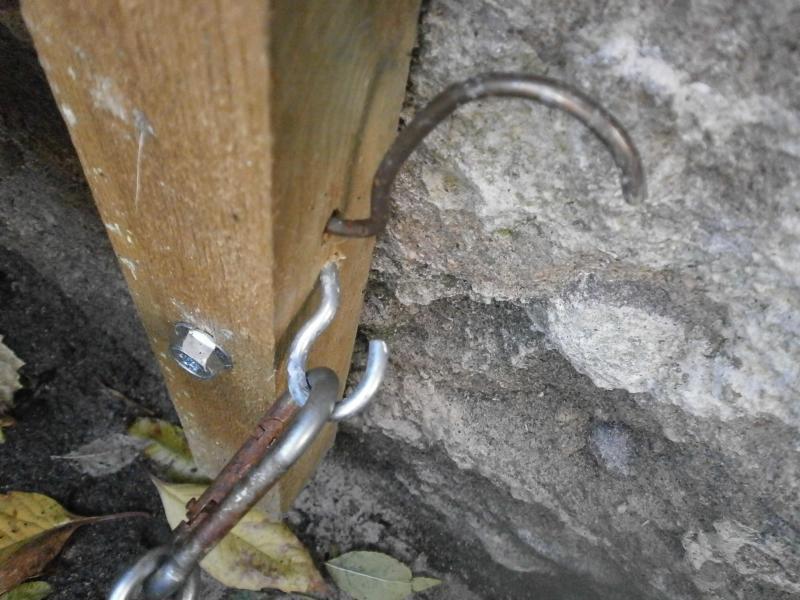
Secondly, once the sheep have experienced that the wall is flexible and weak, they become interested in stepping onto it and jumping over it. Here we can see two ewes involved and the poor wall after it had been defeated:
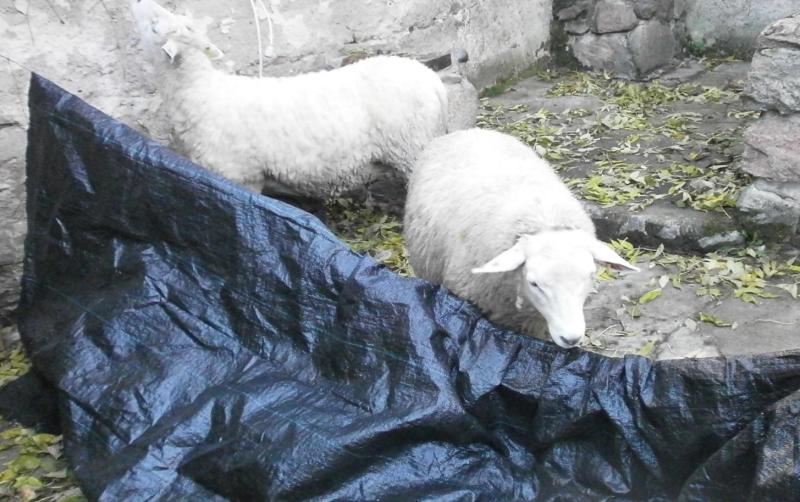
I will write another post some day about how we have fixed the setup and tested new ideas. In the meantime, I am very satisfied that I can basically handle our sheep peacefully and on my own. Of course, their cleverness, curiosity and playfulness add a lot of adventure to the endeavor and encourage us to think like engineers. However, we have built a proof-of-concept and I feel good.